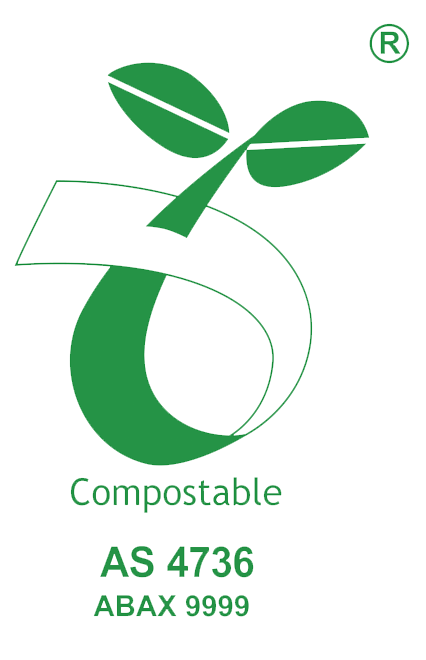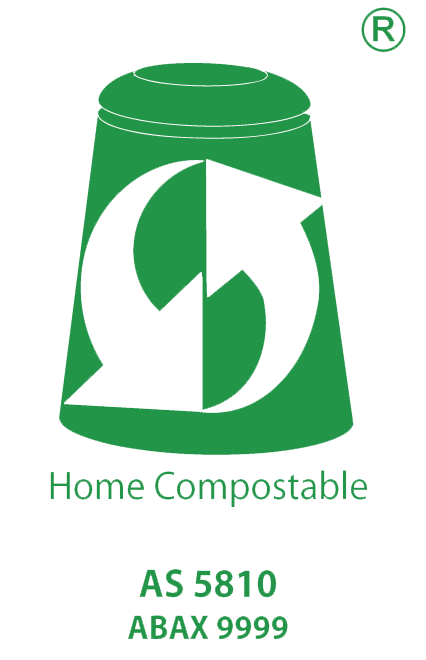Australian Compostability Standards: AS4736 & AS5810
In Australia, there are industry standards that determine and regulate what can be labelled as ‘compostable’. In this article we explain some key terms surrounding sustainable packaging and the solutions we currently provide.
Biodegradable vs Compostable: What is the Difference?
What do we mean by ‘biodegradable’?
In the plastic packaging industry, ‘biodegradable’ was often used to refer to plastic bags breaking down in landfill or in natural environments. However, the term has little significance without industry standards or benchmarks against which we can determine the ‘biodegradability’ of a piece of plastic. In fact, there is nothing that does not degrade in nature. Even steel oxidizes and corrodes over time but this process can take many years just as it does with plastics.
So what do we mean by ‘biodegradable’? In the plastic packaging industry, the term has referred to plastic packaging to which additives were added, for it to more rapidly disintegrate in landfill or nature. Whilst this was a step forward, it is not the silver bullet we need when it comes to reducing waste. This process can still take many years but what is more troubling is that it leaves toxic residue or micro-plastics in the environment. Some might argue, that we are no better off with this solution. So, what then?
What is ‘oxo-degradable’?
Even more recently, particularly the early 2000s, ‘oxo-degradable’ became quite popular in the plastic packaging industry. Similar to ‘biodegradable’ packaging, oxo-degradable packaging also consisted of additives that allowed it to break down anywhere, as long as oxygen was present. Over time, bags would break into smaller fragments and eventually break down into microplastics (sound familiar?) however, it too was not the solution to our waste problems. Not only did it still take time but the microplastics would be found in more populated areas, posing a danger to humans and animals.
What is compostable packaging?
Enter, ‘compostable’ packaging. Why ‘compostable’ and not ‘biodegradable’? Even though we may use the term interchangeably as most people understand the term ‘biodegradable’ rather than compostable, what we really mean at Adventpac is compostable. When we say our Greenpac™ is 100% compostable, we don’t mean ‘biodegradable’ in the traditional sense.
Composting is a form of waste disposal where organic waste such as food decomposes naturally under oxygen and microbe-rich conditions. There are industrial compost facilities and composting systems for the home (e.g. a worm farm, a compost bin, or bokashi system). It is in these facilities or systems that compostable packaging should be disposed of. Why? Well, compostable packaging is made of raw materials (e.g. corn starch) that naturally decompose in microbe and oxygen-rich environments just like organic waste. The benefit of this is that not only does the packaging not end up in landfill but when turned in compost, can help fertilize plants and vegetation. Finally, a genuine step forward for sustainable packaging! BUT WAIT!
Now, you’re an expert in the technical terms but there’s more that we need to understand. Just because something is labelled ‘compostable’ does not mean it is ‘compostable’. What do we mean by that? There are different compostability standards for compostable packaging and understanding the differences between them will help you determine the necessary conditions required for them to decompose as well as how long you can expect it to take. In Australia, there are two standards for compostable packaging: AS 4736 and AS 5810 which we will go through down below.
AS 4736-2006: Industrial Compostability
In Australia, for a plastic material to be certified as compostable, it must comply with the AS 4736-2006 standard. This standard is similar to the European EN 13432 standard but has an additional requirement of a worm test. The AS 4736-2006 standard provides the criteria against which plastics materials that are to be biodegraded in industrial anaerobic composting facilities, are assessed. It is important to note that industrial compost facilities are very different to home composting systems. Industrial composting facilities are able to process organic waste at high temperatures that cannot be replicated in the home (50°C or higher), thus accelerating the rate at which the waste decomposes. Therefore, just because something has been certified for the AS 4736-2006 standard, does not mean it will decompose in the same way in a home compost system!
In order to comply with the AS 4736‐2006, plastic materials need to meet the following requirements:
Minimum of 90% biodegradation of plastic materials within 180 days in compost
Minimum of 90% of plastic materials should disintegrate into less than 2mm pieces in compost within 12 weeks
No toxic effect of the resulting compost on plants and earthworms.
Hazardous substances such as heavy metals should not be present above the maximum allowed levels
Plastic materials should contain more than 50% organic materials.
Products that meet the requirements above can be endorsed with the ABA Seedling Composting Logo. This logo ensures that these products and materials are easily recognized and food waste or organic waste contained in these certified products can be easily separated out and diverted from landfill.
AS 5810-2010: Home Compostable
Although a home composting system is very different to that of an industrial facilty, the core requirements for the certification remain the same. For a plastic material to be ceritified to the AS 5810-2010 standard, it must undergo stringent testing conducted by recognised and accredited third-parties. Due to the differences between a home compost system and industrial compost facilty, the testing period for this standard is a maximum of 12 months however, the end results remain the same as the AS 4736-2006 standard. That means a minimum of 90% biodegredation, no toxic effect to compost, plants and earthworms and materials should contain more than 50% organic material.
If successful, applicants will be granted the license to use the home compostable logo on their packaging. This logo will help the end consumer, customers and/or municipal authorities to recognise compostable packaging and dispose of it accordingly. More importantly, the Home Compostable Verification logo will communicate the authenticity and independent verification of claims of compliance to AS 5810-2010.
Which Should I Choose?
Due to the extreme and stringent requirements of the AS 5810-2010 standards, it holds true that whichever product meets the home compostable standard, it will meet the industrial standard. The opposite however, does not always hold true. The choice as to which certification you should settle for will depend on who the end user is. At the time of writing, industrial compost systems are not widely available and accessible for the majority of the population in Australia as is the case in many other parts of the world. So, if you know that either you or your customer will not have easy access to an industrial compost facility, it is best to ensure that you choose packaging that has been certified to AS5810-2010 as this will allow anyone with a home compost system to easily dispose of it properly and reduce the amount of waste that ends up in landfill.
Summary: The AS 5810-2010 standard is preferred as industrial compost facilities are still uncommon, therefore it is best to ensure your packaging can be disposed of easily in the home.
As of writing, our compostable packaging solutions are certified to both standards at varying thicknesses. Our products are compliant to AS 4736 for thicknesses up to 192 microns. As for AS 5810, they are certified for thicknesses up to 60 microns however, this is subject to change and will increase to 101 microns.
Compostable Packaging: Proper Disposal
If you are in the market for compostable packaging for your products, it is important to ensure that your customers understand how they should dispose of the packaging. The purpose of compostable packaging is for less waste to end up in landfill, particularly single-use bags. However, if compostable bin liners for example, were used to bag inorganic waste and thrown into landfill it would defeat the very purpose of the compostable nature of the bag. Therefore, we encourage our customers to enclose or attach proper disposal instructions within the contents of their compostable packaging to ensure their customers dispose of them properly.
If you have any questions regarding compostability standards or our Greenpac™ line of products which are fully compostable, feel free to contact us here.
Check Out Our Compostable Products
Disclaimer: as of this writing, our products are certified for AS4736 (up to 192 microns) and AS5810 (up to 60 microns)
The Importance of Industry Standards
Industry standards are crucial as they provide businesses with a basis for mutual understanding through benchmarks and guidelines. Without these industry standards, anyone can claim their product to be superior or of a higher quality without any objective measures in place to say otherwise. Such practices would not only result in misleading or even false information for buyers but it will also tarnish the reputation of the industry. In such cases, corrective measures could potentially result in even more stringent laws and regulation that could impede businesses and industries to operate efficiently.
In the case of compostable packaging, it is important for buyers to understand what a company means when they say their product is ‘compostable’ and to watch out for which standards are being used if any. Not all standards are made equal and understanding the differences between them will mean having the right expectations in regard to how quickly the compostable packaging will break down and the conditions in which it will break down. It will also mean that you will be able to determine objectively, which product is better than which based on the industry standards the comply with.






